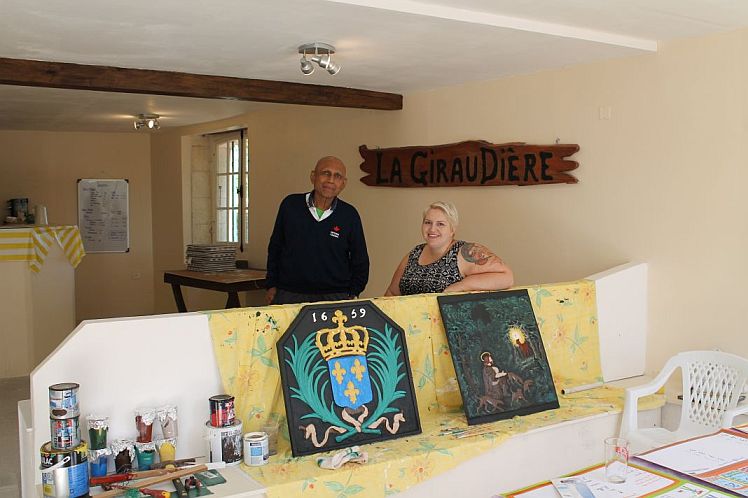The articles you find listed throughout our website were written by Les Amis De La Giraudière, or in English, “the friends of La Giraudiere”, also contributions from volunteers and interns who have participated in the different programs at La Giraudiere. We hope you enjoy.
Plaque de Feu à La Giraudière
Article about the plaque de feu found at La Giraudiere in France. During the restoration of La Giraudiere some Fireplace Fireback / Plaque de Feu were found Here at Giraudière, two cast iron fireplates plaques, fabricated in 1659, were found in two different fireplaces of the original Master’s house which was built around that time.
The first plaque is hexagonal in shape approximately 70 centimeters in width and length. At the centre is a shield showing the fleur-de-lys, once the symbol of the French Kingdom. On top of it is the Royal crown, symbolic of authority. On both sides, flanking the shield and crown are two palm branches, which since antiquity have been symbolic of victory, triumph, peace, and eternal life. Christianity sees the palm branch as victory of the spirit over flesh.

The second plaque is a square of the same dimension. At the base is Saint Eustace, a 2nd century patron
saint of hunters, and anyone facing adversity.
Eustace was the Roman general Placidus, who while hunting in Tivoli near Rome, saw the vision of a crucifix
stuck between a stag’s antlers. This affected him so much, he decided to convert to Christianity.
A little about the history of Plaque de Feu
A fireplace fireback, placed against the back wall of the fireplace, is a piece of heavy cast iron, sized according
to the fireplace and the fire. The houses on which these fireplaces are seen cover a wide range from mansions to humble cottages, the majority to be found in the homes of poor people.
While its primary purpose is to protect the wall at the back of the fireplace from cracking and chipping
this was especially important with daub, (a mud-straw mixture coating on interwoven wooden wattles), brick,
and soft stone. With the development of cast iron, protective metal plates allowed fires to be placed safely
against walls.
Its secondary function, which is more important to the householder, is to radiate the heat stored in the metal
by the fire. This increases the efficiency of wood fires by 50%, depending on the thickness of the cast iron.
In France, wood burning open fireplaces remained popular, and firebacks continued to be produced there
well into the 19th. century. The oldest fireback dates back to 1460 during the incipient days of iron casting.
Indeed, the early firebacks were decorative with simple designs derived from mundane items such as biscuit
and wafer moulds and were made of brick, stone, and later metal.
Originally, firebacks were luxury items, used exclusively by royalty and aristocracy. Thus, the early firebacks
show their crowns and coats of arms. Later, the firebacks, popular also in Germany, recorded more
decorative and pictorial designs with religious, mythological, and allegorical themes as well as classical
stories involving churches, nature, and rural lives, always reflecting their timelessness, beauty, and
historical significance.
With the increasing use of coal and natural gas, the decline of firebacks was inevitable. Nevertheless,
even today, companies in the United States and England replicate some of the antique fireplaces.
Plaque au Feu is an article written by Reuben Lachmansingh describing the history of the French fireplace
fireback and those found and restored at La Giraudiere.
How would you like to have your own page upon our website? You can how you say? simply by writing an article and sending it to us together with two photographs that relate to the article. La Giraudiere is a well-respected website among its visitors and also by the search engines that regularly visit.

